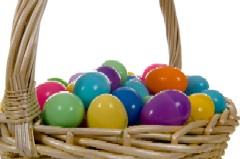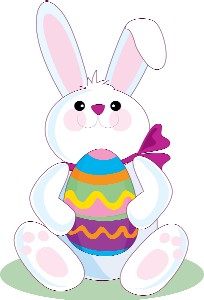Easter Eggs
Holidays Trivia Easter would not be complete without brightly colored Easter eggs, but have you ever wondered where this tradition began? Who thought of painting the shells of eggs such bright, even ornate colors? When did children begin dyeing eggs as part of their Easter holiday traditions?
Easter would not be complete without brightly colored Easter eggs, but have you ever wondered where this tradition began? Who thought of painting the shells of eggs such bright, even ornate colors? When did children begin dyeing eggs as part of their Easter holiday traditions?
While Easter is known as a Christian holiday, where believers celebrate Jesus Christ’s resurrection and the new life they are offered, the tradition of the Easter egg goes farther back in history, before the life of Christ. Eggs have always been a symbol of both fertility and new life. These themes are common in spring holidays around the globe and throughout history. The ancient Egyptians were known to use eggs in their spring festivals, many of which fell around the time of today’s Easter holiday. The same is true of Persians and Romans.
Easter Eggs have a measure of religious history as well. The Catholic celebration of Lent in medieval times forbade the church members from eating eggs. As food was scarce in this century, the eggs that were laid during these weeks of fasting were not wasted. Rather than tossing them out, many were preserved, often through boiling. Easter was the time to break the fast of Lent, and the preserved eggs were an important part of the meal. Even children enjoyed receiving eggs at Easter as gifts, since they had been forbidden for so many weeks. Servants were also given an egg at the Easter dinner, a rare treat for those in the medieval serving class.
So where did coloring Easter eggs come into the story? Early Easter eggs were painted bright colors to announce the coming of spring. During the beginnings of Christian history, eggs given at Easter were dyed red to symbolize the blood of Christ.
Polish tradition seems to be where the painted Easter egg and Christianity began to intertwine. There are two Polish legends that show the colored egg as a part of the story of Christ. One story tells of Mary, Jesus’ mother, at foot of the cross. In desperation she implored the soldiers to be less cruel to her son. In return, she offered them eggs. As she cried, her tears caused the eggs to spot with bright colors.
The other Polish legend speaks of Mary Magdalene. The story shows Mary visiting the tomb where Jesus’ body was laid. She brought eggs to eat for lunch before anointing the Savior’s body. When she uncovered the eggs at the entrance to the tomb, they had turned from white to bright red, green, blue, and yellow!
 These traditions spread throughout Europe, and the Russians became famous for their egg decorating abilities. Czar Alexander had a goldsmith named Peter Carl Faberge that he commissioned to create Easter eggs for his wife. The brilliant artist built an egg with a smaller egg inside. Each egg opened to reveal hidden treasures inside. The intricate Faberge eggs designed by artists since then have been named in honor of the artist.
These traditions spread throughout Europe, and the Russians became famous for their egg decorating abilities. Czar Alexander had a goldsmith named Peter Carl Faberge that he commissioned to create Easter eggs for his wife. The brilliant artist built an egg with a smaller egg inside. Each egg opened to reveal hidden treasures inside. The intricate Faberge eggs designed by artists since then have been named in honor of the artist.
Of course, Easter eggs and children seem to go hand in hand. Games involving the egg abound around the world. In Europe, one popular Easter game is egg rolling. Children roll boiled eggs down hills in a fast-paced race. Every year in America, children flock to the White House for an egg roll. English children enjoy a game called “egg dumping,” where they battle by hitting their opponents’ eggs with their own. The winner is the egg that does not break. And of course most children dye and hunt Easter eggs on Easter Sunday. The Easter egg hunt has becomes so popular that companies have made beeping Easter eggs! These incredibly designed eggs emit a series of beeps or clicks that allow blind children to participate in an Easter egg hunt!
With such a long and varied history, we can be certain that the Easter egg is here to stay. The colorful creations are an integral part of Easter tradition, and if there are children in your life, be prepared to dye a few Easter eggs each spring! The delight on the child’s face will be well worth the effort!
